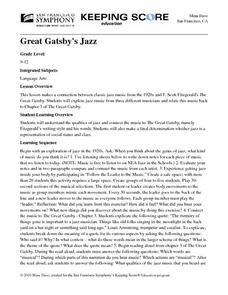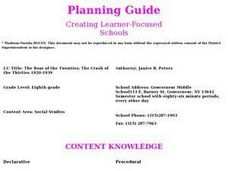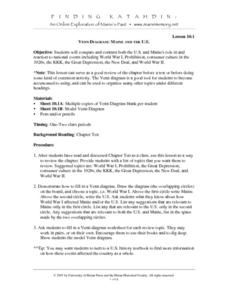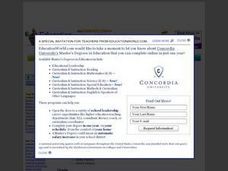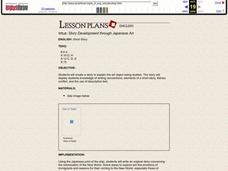Curated OER
The Great Gatsby: Primary Sources from the Roaring Twenties
Students research the Roaring Twenties. In this 1920's America lesson, students analyze primary sources to develop an understanding of lifestyles and values of the era as they read F. Scott Fitzgerald's The Great Gatsby.
Curated OER
You Wouldn't Understand...It's a Slang Thang
Fourth graders study a decade in history through its slang. They analyze a slang dictionary from the 1920's and read a primary source letter making use of the slang. They decipher the language and compare and contrast 1920's language...
Curated OER
Roaring Twenties: The Impact of High School on its Students Over Time
Eleventh graders compare the American high school experience of the 1920's to today. In this historical perspectives lesson, 11th graders examine surveys from 1924 high school students and then create their own surveys for today's high...
Curated OER
Early Jazz
Students gain an understanding of early jazz. They study Dixieland and the Roaring Twenties. They examine the American historical significance and cultural implications of early jazz.
Curated OER
Great Gatsby's Jazz
As Nick wanders the grounds of Gatsby's mansion, he observes the behaviors of the rowdy guests and listens to the music pouring over the lawn. Bring the music of the jazz age into the classroom with Louis Armstrong's "West End Blues,"...
Curated OER
The Roar of the Twenties; The Crash of the Thirties
Eighth graders, after assuming identities of prominent figures from the 1920's and looking at slides and data from the era, relate, in diary form, the cultural, economic and political changes that happened in America between 1920 and 1939.
Curated OER
Venn Diagram: Maine And the U.s.
Students compare and contrast major events in U.S. histroy using a Venn diagram. They focus on how the events affected their state and the country as a whole. Events expolred include World War I, the Great Depression, Prohibition, the...
Curated OER
The Other Side of Paradise
Eleventh graders explore the life and writing of F. Scott Fitzgerald. They examine the youth culture of the 1920's and compare it to their own. They practice using some of the biographer's or archivist's tools for studying a person.
Curated OER
Key Ingredients: America by Food
Learners participate in a series of activities to explore the types of food Americans eat, how food choices differ in various parts of the country, and how the availability of various foods has changed over time.
Curated OER
Key Ingredients: America By Food
In this set of five lessons, students analyze the important of food traditions, identity, and history. Students analyze how food traditions contribute to family identity, investigate family food traditions through interviews, and compare...
Curated OER
From The Great War To The Great Depression
Discover details about 1920's America. In this American history lesson, students read From the Great War to the Great Depression. Students then research famous Americans from the time period and present their findings to their classmates.
Curated OER
"And That's The Way It Is..." Today in History
Young scholars research an event in history from different perspectives. They discuss the characteristics of a nightly news broadcast and create their own based on the history event they researched. They work together to produce this...
Curated OER
STORY DEVELOPMENT THROUGH JAPANESE ART
Eighth graders create a story to explain the art object being studied. The story displays students knowledge of writing conventions, elements of a short story, literary conflict, and the use of descriptive text.






